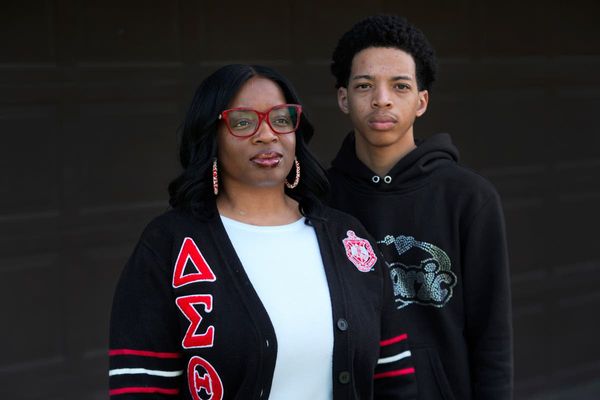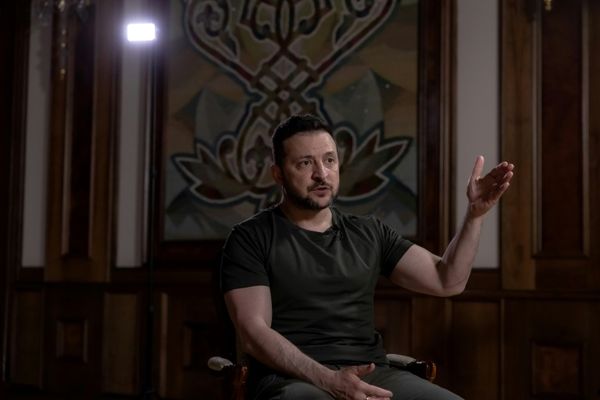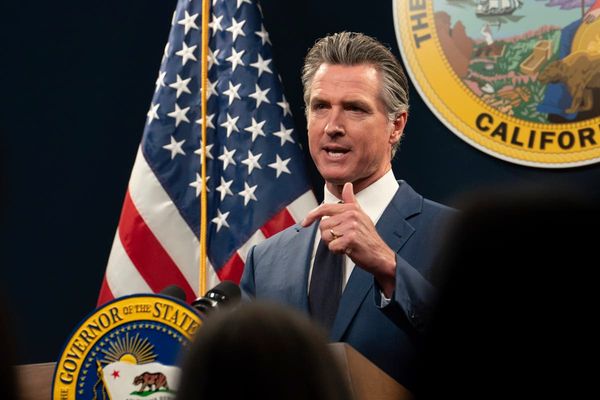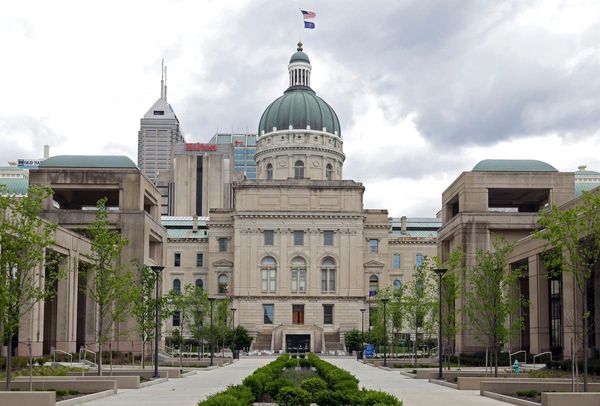
"Ayrton Senna is joining Williams..." I have to say that even though I was the team manager at the time, I had a certain feeling of trepidation when I heard this news. It was pretty daunting, because he was Ayrton Senna... he was coming with a little bit of a reputation.
I suppose we thought he might be difficult to work with - all of the top drivers were demanding, but it was something we'd got used to. We'd had Nigel Mansell and Alain Prost at the team, but nobody quite knew what Ayrton would be like. Still, we were professional and we knew what we were doing.
I first met him at Williams's factory over the winter, probably at the start of 1994. He popped in for five minutes to say hello and he was quite quiet and extremely polite. That was the thing that immediately struck me about him. He was very calm. He was direct and matter-of-fact.
You could see he was trying to weigh the place up because we were different to McLaren, where he'd been for six years. McLaren had been moulded around him and he had to start that process all over again with us, but we were determined to make him feel as welcome as possible.
The relationship was very new at the first race and, after first practice, we were in the debrief room looking at the time sheets. Ayrton's race engineer, David Brown, said something like, "Bloody Senna is always there or thereabouts isn't he?" to no one in particular. Ayrton, who was sitting next to him, just looked sideways with an enquiring look. David turned the colour of a beetroot. "Sorry mate, force of habit," he said. There was a good atmosphere about the place.
Although things hadn't been going well over the start of the season, there was no panic from Ayrton himself. He was calm and determined to help the team get to the root of any problems we had with the car. He got his head down, worked with the team and was pulling us in the right direction. He was prepared to work - and to work hard. He wasn't jumping up and down when things weren't going right.

After he spun off in Interlagos chasing Schumacher, he came back into the garage where I was with David Brown. He apologised for going off and said that it wouldn't happen again. I think that really summed up the bloke.
Still, working at Williams, the pressure was always on. And after two non-finishes in the first two races of 1994, it was really on. There wasn't a 'let's wait and see' attitude. Things had to change and we were pushing hard.
It had become clear that something was not right with the pace of the car Ayrton Senna and Damon Hill had, and the engineers were trying to figure out what it was. It was down to the powers that be, Adrian Newey and Patrick Head, to sort it out and they'd identified that there was something amiss and that it was an aerodynamic issue of some kind. There was a frustration and we were wondering why the car wasn't quicker because, by rights, it should've been.
I didn't think Ayrton's actions in going to the scene of the [Ratzenberger] crash were strange at the time because he was the man in motor racing
It wasn't that the car lacked outright pace. Ayrton had put the thing on pole for the first two races, but it was a struggle when the green light came on; we didn't seem to have race pace and Ayrton had retired from the opening two grands prix of the season. We'd only had one podium with Damon Hill, but Williams weren't the sort of team who panicked. We started going through everything properly and methodically and we'd put some upgrades on the car for the race in Italy. By the time we got to Imola that weekend, everybody was gagging for a result.
Qualifying on Friday went well for us. Senna went out and did 1m21.5s, which was half a second faster than Michael Schumacher's Benetton; Damon was seventh. Apart from a spin by Damon, I can't remember any huge dramas for our team, but that wasn't the case everywhere. Rubens Barrichello had a major off at Variante Bassa and was knocked unconscious. It was a big accident but he survived it and things carried on as usual.
Then we got to Saturday qualifying and Roland Ratzenberger's accident. It was 20 minutes into the final session of the day and Ayrton hadn't even gone out to do a time by that stage. Damon had done some laps and was second fastest in the session, which was enough to put him fourth on the grid. Then there was a red flag and the news began to filter back to us that Roland's accident had been a big one.
Ayrton went to see for himself what had happened in Ratzenberger's accident and he also went to the medical centre afterwards. You might think that this was an unusual reaction, but he was a humane guy. I didn't think Ayrton's actions in going to the scene of the crash were strange at the time because he was the man in motor racing. He was the top man. He was a bloke who was passionate about motor racing and Formula 1.

He was interested in the sport and he wanted to know what was going on with everybody. He was wrapped up in it and this was one of his ways of showing it. Ayrton was always up front with everything and he wasn't a bloke who shied away from saying what he thought, which for me was great. I think going to the scene and then to the medical centre was just his way of dealing with it. He was interested in safety and deeply concerned with humanity. He had a thing about that.
One thing that struck me about Senna's reaction, though, was that we didn't really know him - we didn't know him at all. The relationship was just beginning to get there. It was starting to get to the stage where if he wanted something, he would just come and ask me.
I remember before Imola, Frank Williams had asked me how it was going with Ayrton and I said that the bloke was fine but that I wished he would just come and speak to me if he wanted something. That was what I was there for.
During the early part of the season, his manager would come and speak to us if there was something Ayrton wanted but for it to have worked properly, I knew that we needed to build up that personal relationship with him so we could give him what he wanted. Well Frank must have had a word in his ear because during that weekend at Imola, he was different. He was asking me "Can we get this?" and "Can we do that?" It wasn't a problem.
I remember that after the Ratzenberger accident, Charlie Moody, who was the team manager at Simtek at the time, came to see Adrian. I remember it like it was yesterday. We were sat in our awning and I just think he needed someone to talk to. I remember going back to our garage afterwards and thinking, 'Christ, what on earth must this poor bloke be going through?
We didn't take part in the second part of qualifying after the red flag. Schumacher had improved his time but it wasn't enough to take pole position away from Ayrton, while Damon was on the second row. We had a shock on that Saturday with the accident, but the Williams team were a bunch of professionals and they just put their heads down and got on with the job. It's just the way the team were - there was still a race to prepare for.
F1 was a lot less complicated in those days and it's quite amusing to think back now about how we used to prepare. On the Sunday morning, we would cycle through a programme that isn't a patch on modern racing. It was almost like, 'Off we go, here we are chaps, let's go motor racing!'
Damon, Ayrton and myself went to the drivers' briefing in race control and then straight after that we went into an engineering meeting. Engineering was the core of Williams; that's what made it what it was. I went through the rules - just the petty stuff like 'watch the pitlane entry', 'don't go over this line or that line' and things like that. It was easier back then because there weren't nearly as many rules in Formula 1 at that stage as there are today. We went through the warm-up session and, again, Ayrton was first and Damon second. It was all going well.

In the build-up to the race, we did practice pitstops because it was the first year of refuelling. While the guys were doing that, me, David Brown and John Russell, the engineers, sat down and worked out the final calculations for the fuel stops. It wasn't like today where you can press a button on a computer and it works it out for you.
We had to look at the fuel usage from qualifying and from the warm-up and then we were looking to see what other factors we'd have to take into account at Imola. We thought about whether the guys would have to turn up their mixture at any stage, what the weather was likely to do and things like that. Ayrton and Damon were involved in the decisions too, and we came to a conclusion that we were all happy with.
I had these little cards printed up, and I wrote down what laps the pitstop window would be on and then I went around and handed one to every member of the pit crew so there could be no confusion. The cards also said what fuel loads Ayrton and Damon wanted in their cars.
Ayrton himself was convinced that there was something different about Schumacher's car. I know that because I'd gone to meet him after his first-corner accident at Aida in Japan
Finally, before the race, we had a strategy meeting so that everybody knew exactly what was going on. Whenever you do that, you have to build in a degree of flexibility in case something happens or something changes during the race but that was all agreed. All I remember was that it was a pretty flat-out build-up to the start. Race days were always a blur and it was usually a rush to get my overalls on at the start because I'd be working right up until the last minute.
I remember one of the things the paddock was getting obsessed with at the time was Schumacher's Benetton and its electronics. There was all sorts of paddock gossip about traction control, which seemed to be the norm at the time. Ayrton himself was convinced that there was something different about Schumacher's car. I know that because I'd gone to meet him after his first-corner accident at Aida in Japan and we walked back to the pits together.
Senna was still on a suspended ban after decking Eddie Irvine after the race at Suzuka the year before, so I thought I'd better go and find him after the Aida crash to make sure nothing else kicked off.
When I got to him, he was walking back and he was very calm. We stopped for two minutes to watch in the infield section. Ayrton said to me that he thought there was something different about Michael's car. Whether there was or not I don't know, but Ayrton was utterly sure that there was. On race morning at Imola, I got Richard West, who was the commercial manager of Williams, to get a video camera and go up onto the roof of the garages to record Schumacher's start to see if he left thick black lines on the Tarmac, like you'd expect.

Everyone was pretty matter-of-fact about the weekend. Ratzenberger's accident had already cast a dark gloom over the paddock, and then there was another huge accident at the start when JJ Lehto, who'd qualified fifth, stalled on the grid and Pedro Lamy's Lotus smashed into the back of him. Bits flew into the grandstands, people were hurt and there was crap flying everywhere. I turned to someone in the garage and said that I thought the whole weekend was getting a bit like chariot racing. It was just 'wham, bam!' Things were happening everywhere.
I was the lollipop man that day, like I always was. Ultimately, we had all the top crew at Williams and it just fell to me to do that particular job. I didn't mind - I wanted to do it. I was the last of the old school and it meant I was responsible for releasing my car back into the race, with no pitlane speed limit in those days, which suited me fine.
Besides, there was John Russell, Patrick Head, David Brown and Adrian Newey up on the pitwall. What the hell was I going to do up there apart from point out the bloody obvious? They were the top men in their field at that time, so I ran the pitlane side of it. That way I could make sure that the fuel was right, that we were ready to go, and that the pitstops went OK.
Frank used to give us a hard time about not being fast enough in the pitstops, so I concentrated a lot on trying to improve that aspect of the team. It was crucial. Not to the level it is now, but it was vital.
After the shunt at the start, the safety car came out. It had been in the rulebook for 12 months and had only been used twice before, so the whole scenario was new to everyone and threw a spanner in the works as far as fuel calculations for the race were concerned. We had to think on our feet a bit but not for long, because the race restarted after five laps. I was in the garage watching on the monitor. Senna held the lead from Schumacher for a lap until he got to Tamburello on lap seven.
We saw the TV pictures... actually the only live TV picture I saw was one where the car disappears behind a wall. I couldn't see it properly because it was a shot looking back from Tosa. I couldn't see the actual impact but I could see the shit flying up and all the rest of it. Then there was another camera shot of the crash and I immediately thought, 'That was a big one.' There'd been some big crashes at that corner before, like Nelson Piquet in 1987 and Gerhard Berger's Ferrari in 1989. Those drivers had walked away.
I remember looking at it and after probably about 10 seconds I just started saying, "Move, move." We'd seen Ayrton twitch inside the car and that represented movement. So there was hope. Initially. Then there was nothing. It just stopped. It became obvious that there was a bit of an issue but nobody knew how serious it was.

They stopped the grand prix and I went up to race control. I walked the length of the pitlane from where we were based in the middle of the pits, because we were the world champions and we had the biggest garage. As I walked, I started to register that it didn't look very good and one of the guys from Arrows, I think it was, patted me on the back as I went past. I didn't acknowledge it at the time but that made me think. I was beginning to realise that this could be really serious.
I got to the officials' office and it was a scene of controlled panic. The officials could see that there was something big unfolding. There was loads of talk going on in garbled Italian; people were speaking at 100mph and it certainly wasn't as organised as it is now. It was all a bit different at Imola. No disrespect to the guys there, but this was a massive incident and there was total pandemonium.
I was up there with a radio in communication with the team, because Damon had gridded up ready for the restart and the crew needed to know what was going on. After a few minutes in race control Bernie Ecclestone turned up and started organising it. He was talking to everyone, sorting things out. He became the focal point of the whole thing.
I'm adamant it happened because it was one of the first times a safety car had been used; the tyre pressures were low, the car was running low anyway and it was full of fuel
He turned around to me as it was all getting a bit fraught and said, "What are you doing here?" I told him that I'd come to see what was happening with my driver and he just turned around and carried on with what he was doing. He was organising it and I hope he thought 'fair enough' and didn't answer me. He left me there, which was fine.
A couple of unofficial reports came through that Ayrton had a broken shoulder and that he had been knocked out, something along those lines. It came from someone in the control tower who could speak English. Once I had heard that, I decided to go back to the team because I needed to go and tell Frank what was happening. I told him that although I'd heard it third-hand, the report was that Ayrton was basically OK.
In the meantime, Patrick and Adrian had been getting on with checking the remote data, trying to see what had happened because, by this time, there was a picture of the steering column sitting on the sidepod of Ayrton's car. They quite rightly went through the data and told Damon that they couldn't see anything fundamentally wrong with his car.
Eventually, Ayrton's car came back to the garages. The officials impounded it, but somebody, and I don't know who it was, insisted that we could pull the data off the car - or at least get what we could because it was all smashed up on that side. We were able to get some data from it; it wasn't a massive amount, but it was enough from what I understand, and Damon decided to continue in the second part of the race. A big man's decision.

I went back up to the organiser's office but I can't really remember anything about the race from that point onwards. I spent most of the time in race control trying to find out from the people there what was going on. I knew by that stage that Ayrton had been taken off in a helicopter, obviously, but everybody was hoping for the best. We thought he might have been a bit smashed up, but that was the extent of it.
After a while in race control, I was called into a little side room where there was this Italian lawyer who spoke really good English. He told me what the situation was. He told me that Ayrton had died in hospital.
In Italy they treat it as a road traffic accident and so all of a sudden I was the 'responsible' person in the eyes of the law... I had to sign a load of papers. The lawyer was very good and he went through it all with me. It was a total blur. I had to go and get my passport, which they then took off me. Eventually, they gave it back and they were OK with everything. The people at the track were good but it took a while to go through the whole process.
By the time I got back down to the garage, the flyaway Williams crew had gone home and it was just me and the truckies left, packing the things away. I went in to see [Ecclestone's Austrian caterer] Karl-Heinz Zimmermann as he was in the next bit of the paddock to me and we were quite pally because I could speak the lingo.
He was in his little unit, very upset, but having a schnapps while he was at it. He's a proper bloke. He kept saying to me, "Come on Ian, you've got to have a drink." I remember saying that I shouldn't because the boys were still there packing up and I really needed to be there supporting them. I had to make sure they were alright and I guess I was on autopilot.
We'd been staying in Faenza and the people at the hotel had been great. I managed to book the remaining crew back into a hotel in Imola overnight rather than go to the airport, which was no easy task in the days before proper mobile phones and internet access. We'd all missed our flights, what with the delay.
I guess there were about six of us, and we went out for a pizza. When I got back to the hotel, I managed to get hold of Ann Bradshaw, who was Williams' PR. She was at the airport and she told me that they'd managed to find a side room for the crew to get them out of the way of the press and everything and that the guys had got back to the UK without a problem.
PLUS: The PR legend who lived through Williams' triumph and tragedy
Early the next morning I got a call from one of the lawyers to say he was coming to pick me up and take me to the mortuary. I'm still not sure why they needed me to go, but I did what they said.

When I arrived, Senna's manager Julian Jakobi was there as well as the guy from Senna's sponsor, Varig Airlines. It became clear that they were organising everything and it was all under control. The people at the mortuary asked if I'd like to see Senna, but I said no. I squared everything with Julian. I took a taxi back to the airport. Finally, I got on the flight home.
I got back to Heathrow and nobody was there. Normally there would be someone to collect you but there wasn't so I got a cab from Heathrow to Didcot. It was hugely expensive. I got in and the driver was a typical good old London cabbie.
He looked at my kit and saw I was from Williams. He said, "Hey mate, bit of a shit weekend." I just automatically responded, "Yeah, yeah, it was," and he told me that he had the daily newspapers in the cab if I wanted to read them. So I sat and read the newspaper reports on the way back to the factory. I was just thinking that the whole situation was so sad. So utterly sad.
It wasn't until I got home and my wife and kids came to meet me at the front door that I just fell apart. I absolutely lost it big time
When I got back to the factory on Basil Hill Road in Didcot, it was amazing. There were about 200 people there and this was about 4pm. The front gates were just covered in flowers. I'd never seen anything like it. I actually had to get out of the cab to move all the flowers so that the security man could open the gates to let me in. Luckily no one knew who I was.
I got into the factory and there was no one there except Patrick Head. Normally everyone would be in getting ready for the next race, but the place was virtually shut down. Although I was still on autopilot, it started to hit home when I went to the deserted factory.
It was a bit strange. Up until then, I'd just been doing my job, and then I started to come out of that mode. Patrick asked how it had gone after the team left and I told him everything was sorted out. It wasn't until I got home and my wife and kids came to meet me at the front door that I just fell apart. I absolutely lost it big time.
Then we were into work at 8.30am the next day. Peter Goodman, who was our company lawyer, came in and took statements from everybody about what they could remember from the weekend. The company offered everybody counselling but not one person took it. The T-car and Damon's car arrived back on Tuesday and by the Wednesday morning, everyone was back in and we got on with getting ready for the next race.
By Thursday night, the team had run tests on the rig at Williams and tried to replicate Ayrton's accident from the data they'd been able to get from his car. They tried to simulate a mechanical failure and, from my understanding, couldn't get it to look the same as the data taken off the car.

I'm adamant it happened because it was one of the first times a safety car had been used; the tyre pressures were low, the car was running low anyway and it was full of fuel. If you looked at the in-car footage from Schumacher's Benetton you could see the car was bottoming out really badly from the restart. It was probably a combination of all those things that caused the shunt. I'm not an engineer but I think the thing bottomed out and Ayrton lost the front end.
After Imola, we went to Monaco with just one car. Nobody, and I mean nobody, wanted to be there. Of any race that you've got to do after what had just happened, we had to go to bloody Monaco - the most difficult one logistically on the calendar. The team had to schlep 10 tonnes of kit up to the garages each morning and 10 tonnes back in the evening. What an awful set-up.
On the Friday, Karl Wendlinger went into the end of the barrier and hurt himself badly. To a man, the Williams crew all went and had dinner with the Sauber guys - and we did it quite deliberately I suppose. We sat in their awning and tried to make conversation and support them because of what we'd been through two weeks before. That was Williams and that's the kind of people they had. It was a nice gesture.
The whole atmosphere of the place was down. I remember at the drivers' briefing that people were talking about the start and the first corner and the likelihood of an accident there. I sort of lost it a bit. I said we should start the race under a safety car because they were concerned about accidents at Ste Devote. I remember Gerhard Berger saying no and we had what you might call 'a full and frank discussion' about it. Looking back, I think it was just the emotion coming out.
Damon put the car off on the first lap with broken front suspension after a clash with Mika Hakkinen's McLaren. The mechanics packed up straight away and I sat back in the motorhome, having a beer with Patrick Head and the engineers. We weren't watching the race. I remember Patrick just turning round and saying, "Bloody hell, these things are noisy." None of us wanted to be there. It was a hard weekend to get through and Damon going out early wasn't such a bad thing.
When we got to Barcelona, the fifth race of the year, we were back up to full strength and David Coulthard was in the second car. It was an incredible race and Damon won. Schumacher had been stuck in fifth gear for most of the race and even then you could see the bloke was going to be special - but we didn't care. We'd won. Williams had finished first and that was the race that got the momentum going. After that, we really started to compete. It was a massive result for us.
I've actually got a Renault video that was taken from just over the other side of the pitwall. As Damon's car crosses the line, there's a shot of me, Adrian Newey, John Russell and David Brown. In it, you can see that Adrian and I just fall apart with the emotion of it all - although Adrian recovered a lot quicker than I did, I have to say.
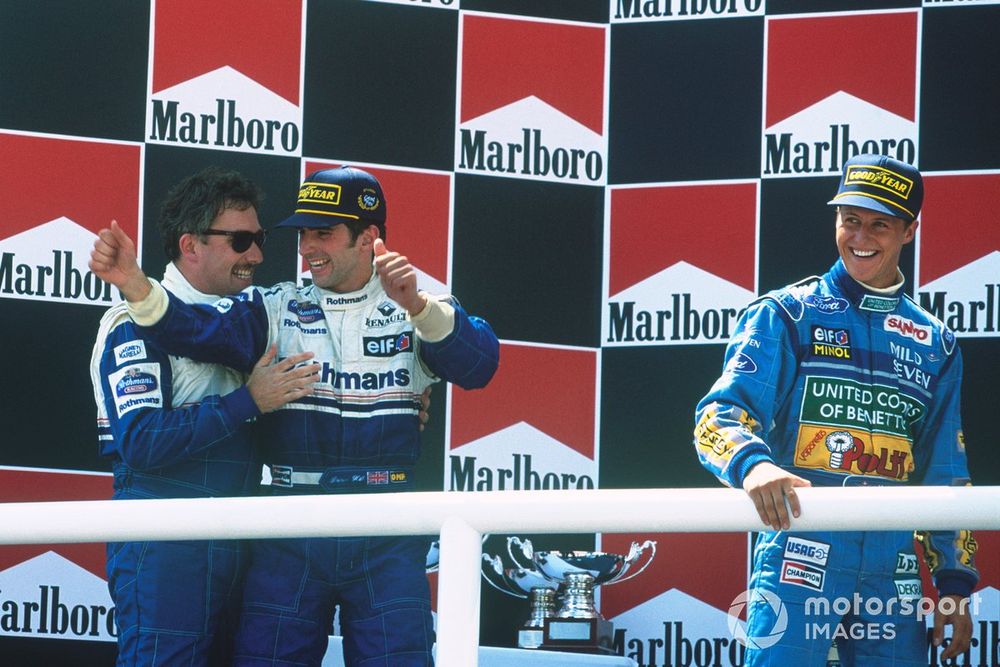
I had to go on the podium with Damon to collect the winning constructors' trophy. It was one of the great privileges as team manager at Williams that I had to go and do it. I had my Ray-Bans on because I was a mess. I didn't want people to see what a state I was in.
I just kept feeling that we were back and the car was better. It felt like we'd seen the light at the end of an awful tunnel. After I'd climbed on the podium and got the trophy, I returned to the team, went straight out to the back of the garage and just bawled my eyes out. It got to the stage where some of the boys were telling me to get a grip and toughen up, but after all we'd been through I just couldn't help it.
We were just beginning to understand him, beginning to see how hard he worked and how determined he was
It's funny how the emotion of that day comes back to me when I see a crash in Formula 1. It really makes me wince, and just takes me straight back to that weekend at Imola. With Ayrton, we were just beginning to understand him, beginning to see how hard he worked and how determined he was. I'm totally convinced that if he hadn't been killed that weekend, he would've won the 1994 world championship.
Like I said, it was just so utterly sad. And do you know one of the biggest regrets I have? We didn't really have time to get to know Ayrton Senna at all.
Ian Harrison was talking to Matt James

